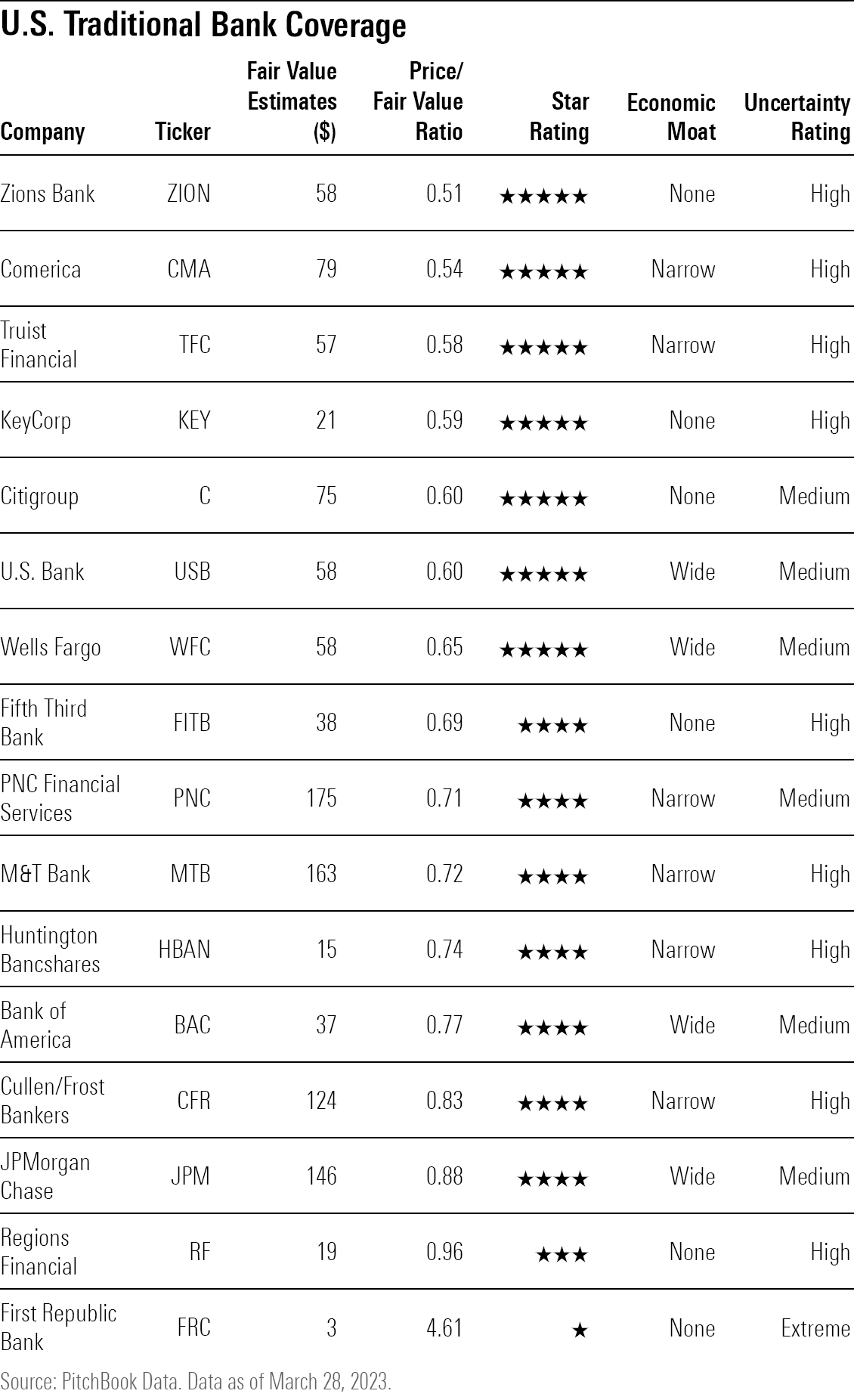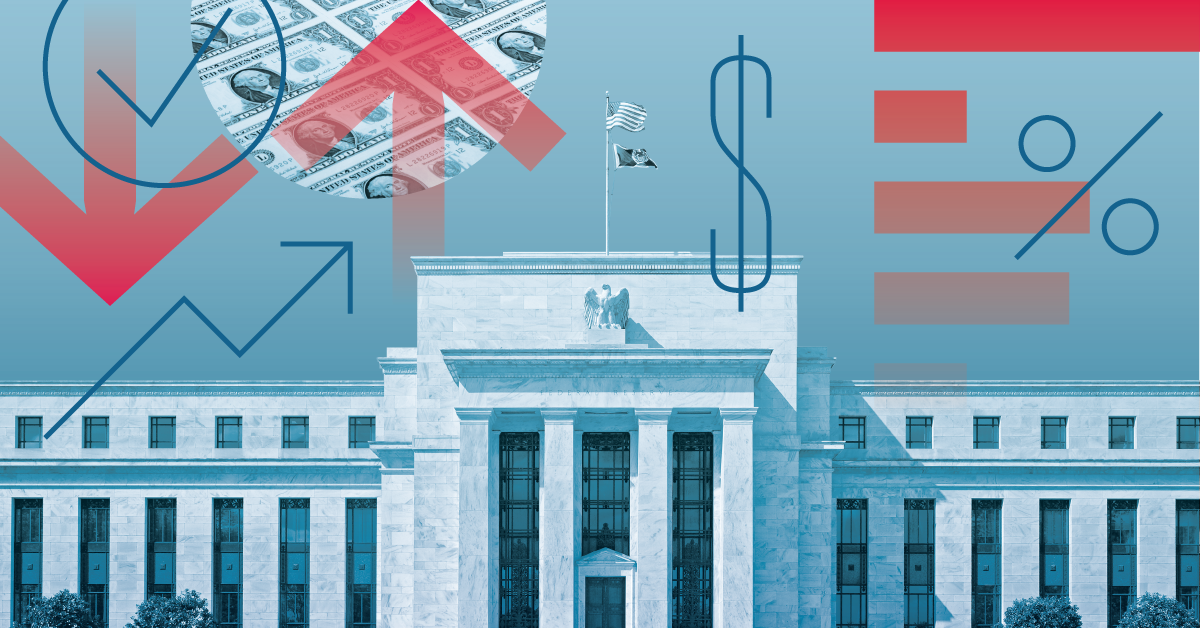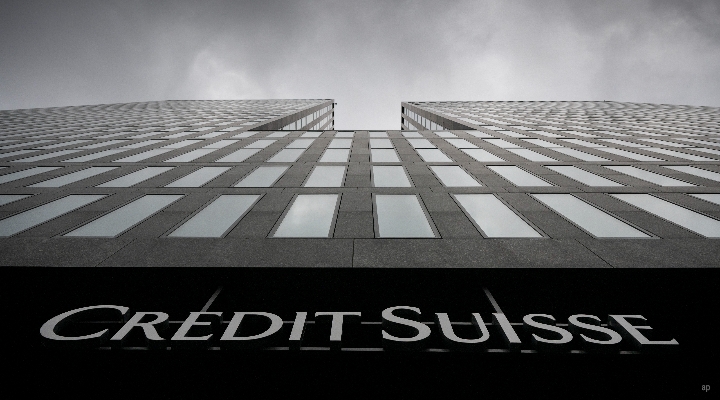
We have updated our fair value estimates for a number of U.S. regional banks in our coverage after the recent banking turmoil. We did this based on an expectation of increased funding costs, some pressure on deposit bases (in other words, deposit outflows), and potentially lower securities yields in the future owing to potential changes in bank regulations (which would likely force banks to hold more short-term Treasuries instead of their current preference for mortgage-backed securities).
Regional Bank Stock Fair Value Estimate Changes
- M&T Bank MTB: US$163 from US$179
- Fifth Third Bancorp FITB: US$38 from US$42
- Regions Financial RF: US$19 from US$21
- KeyCorp KEY: US$21 from US$24
- Huntington Bancshares HBAN: US$15 from US$17
- Comerica CMA: US$79 from US$86
- Zions Bancorp ZION: US$58 from US$66
- Cullen/Frost Bankers CFR: US$124 from US$133
We have, however, left our fair value estimate of US$3 per share and our Morningstar Uncertainty Rating of Extreme in place for First Republic FRC, as we continue to see difficult problems for the bank with no obvious solutions. We think the best outcome for First Republic would be to simply hold on until the Federal Reserve cuts rates, which would make the earnings profile look much better. But how long the bank can hold on and how much damage has been done already to the brand and business model are still outstanding questions for us.
Despite these updates to the regional banks, which caused us to decrease our fair value estimates by roughly 10% to 13% on average, the sector still looks cheap to us. We believe uncertainty levels have increased (and we raised our Uncertainty Ratings for these same banks as a result), and we acknowledge that no one (including us) knows exactly what deposit bases and funding costs will look like when banks report first-quarter results.
Even so, our impression is that while the overall headwinds and risks are well articulated at a basic level by investors, the actual effects of these headwinds (how much would a 5% deposit runoff matter for the value of the bank?) are less well understood. As long as the banks that we cover can avoid a true “run on the bank,” we think the recent selloffs are overdone.
We like U.S. Bancorp USB and Truist Financial TFC, as they have sold off as if they were merely a regional bank despite being more likely to experience deposit inflows, in our view, because of their size. We also like Cullen/Frost because of its conservative balance sheet management and recent insider purchases. We believe the most “at risk” regional banks (KeyCorp, Comerica, and Zions) appear quite undemanding at current valuation levels, seeing their recent selloffs as being overdone (although admittedly the risks are higher for a negative surprise in the near term). We believe that every bank we cover is still likely to remain profitable and cover its dividends.
At this point, we feel that many of the regionals are already pricing in material headwinds, and while there may be one or more negative surprises remaining for some individual names, our sense is that much of the risk is already priced in for the sector. In other words, you are getting paid to take those risks, and to the extent that any of these banks can achieve even moderately bad results (instead of terribly bad results), it would warrant better valuations.
Based on the current risk/reward trade-offs, valuations, and our belief that moderate deposit outflows combined with moderately higher funding costs and moderately lower securities yields should not equate to a share selloff of 30% or more, we are retaining our call on the sector for long-term investors, while highlighting the increased risks.
On a separate note, we did not adjust the fair value estimates for the largest banks in our coverage (JPMorgan Chase JPM, Bank of America BAC, Citigroup C, Wells Fargo WFC, U.S. Bancorp, Truist, and PNC Financial Services Group PNC), as we expect that they are less likely to face deposit outflows (with most likely to see increased deposit inflows in the near term) and therefore are less likely to face funding cost pressures. We’ll know much more and will keep investors apprised of the environment once first-quarter results start arriving in the next several weeks.
The latest H8 data, which is U.S. commercial banking data released weekly by the U.S. Federal Reserve, suggests that there have been some outflows from smaller banks (defined as banks not in the top 25). In our coverage these banks would include Regions, Zions, Comerica, and Cullen/Frost. The smaller banks lost roughly US$120 billion in deposits through March 15, or roughly 2% of their deposits. Meanwhile, borrowings increased US$250 billion, while cash was up roughly US$100 billion. On the other side of things, the top 25 largest banks have gained some deposits of late, with borrowings increasing US$250 billion and cash up around US$300 billion.
This data supports our overall view that the largest banks are likely to see deposit inflows in the near term while the smaller banks are more likely to experience deposit outflows. It also comports with the view that there has been an elevation in stress on the U.S. banking system, which is also supported by increased borrowings from the Fed’s discount window (up US$106 billion), the Bank Term Funding Program (up US$54 billion), and an increase in Federal Home Loan Bank debt issuance.
That said, H8 data from the Federal Reserve data is not detailed enough to really let us know how many or which banks are currently in trouble. Depending on what assumptions one makes, this could represent a small stress on the overall system or a major issue for several banks. In other words, we don’t know how broad or concentrated the deposit outflows are, and even with the largest banks (that saw net deposit inflows), there could still be a mix shift from the smaller top 25 banks into the largest of the top 25 banks.
Our interpretation is that the stress does not seem to rise to a level that puts the whole banking system at risk. However, there is still room for one or more negative individual surprises when the banks report first-quarter earnings, which we likely won’t know for sure until earnings are released (unless management teams drop their bad news ahead of earnings). We now forecast deposit base declines of 5% to 10% for most of the regionals in our coverage, which is worse than what the current H8 data implies.






















